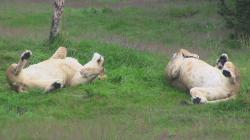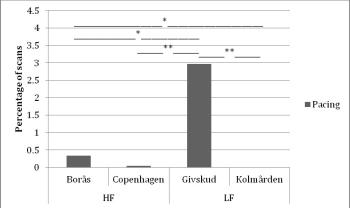Discussion - Activity
Inactivity and Activity

The lions on HF feeding and the lions on LF feeding spent a similar proportion of time with inactivity and activity.
Elliott et al. (1977) found a positive correlation between the amount of food ingested and time until lions started foraging again. Wild lions in the Kalahari desert have been reported not to walk while having a full stomach (Elliott 1984). Accordingly, lions on both feeding regimes were more inactive during feeding days and more active during fasting days. As each lion held on HF feeding ingested 5-6 kg per feeding, their activity during feeding and fasting days was high (...), indicating a lack of satiation. In contrast, the lions on LF feeding each ingested approximately 33.3 kg of meat and were less active during feeding day and fasting day 1.
Feeding

Lions on HF feeding spent on average more time with feeding than lions on LF feeding, as the former received fresh food every second day, which resulted in a continuous supply of food scraps in the exhibit.
The proportion of time spent feeding was almost evenly distributed between feeding and fasting days in HF zoos. In contrast, lions on LF feeding fed mostly during feeding days and very little during fasting days.
My data show that the lions on LF feeding occupied themselves with the carcass for at least two days. This resembles findings in the wild (Eloff 1984). However, the lions on HF feeding spent a considerable amount of time feeding given that they were usually finished feeding within an hour. On the one hand, these lions engaged in gnawing on the leftover bones, which is unusual for wild-living lions (Van Valkenburgh 1996). On the other hand, both lion prides on HF feeding received environmental enrichment in the form of food, which increased the proportion of time spent feeding for those lions.
Pacing

On average the lions on LF feeding paced significantly more than the lions on HF feeding.
However, while the proportion of time spent pacing in Givskud (LF) was significantly higher than the proportion of time spent pacing in any other zoo, the lions in Kolmården (LF) did not pace at all (see Figure 1).
It is apparent that other factors than feeding regime have influenced pacing behaviour in the two LF zoos.
Responsible for this page:
Director of undergraduate studies Biology
Last updated:
05/16/17
